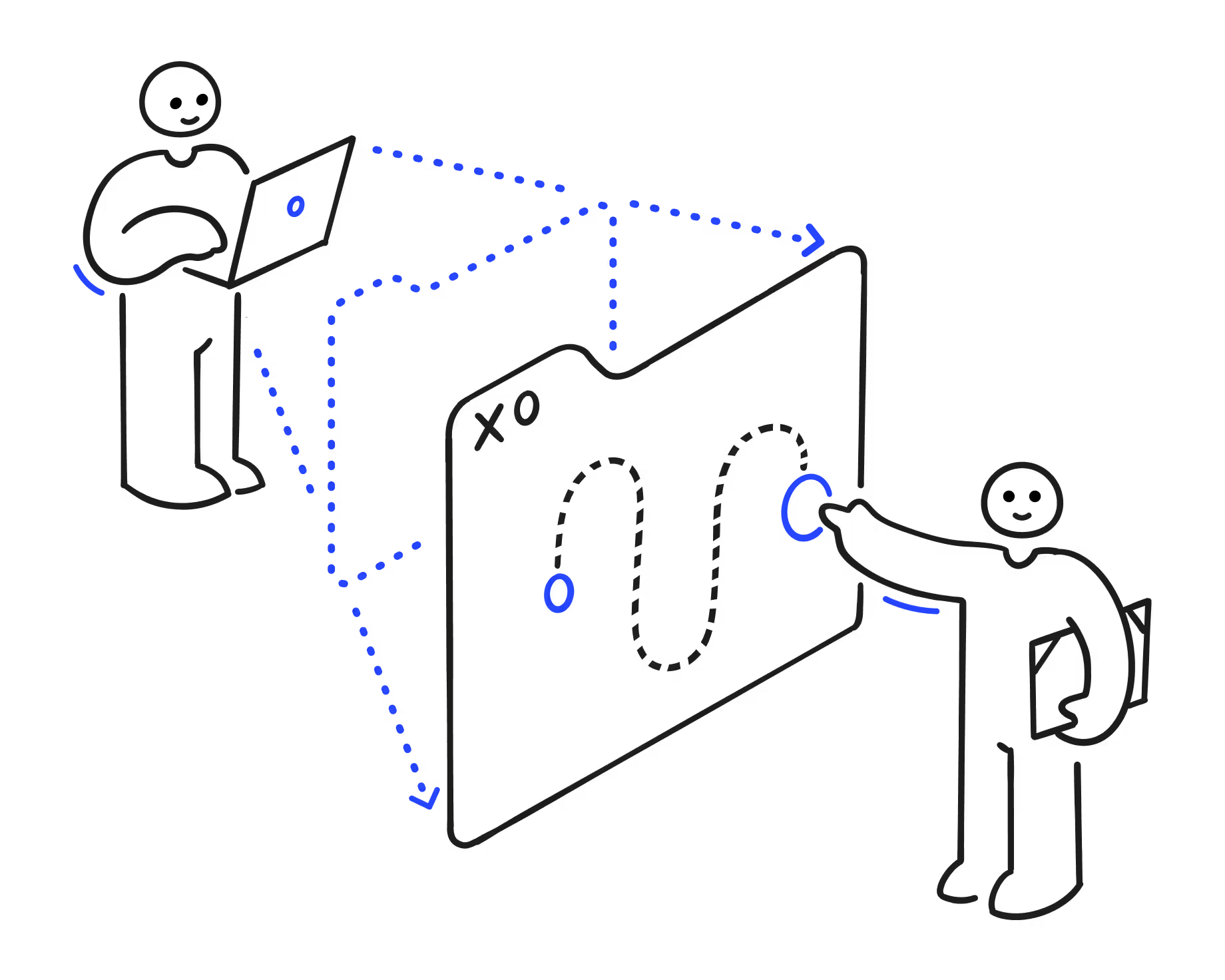Internal communications management: Strategies that work

Discover Workleap Officevibe's benchmark report on 12 key employee engagement metrics

Cold leads. Missed deadlines. Employees on the brink.
These are all symptoms of the same common problem: broken communication. When messages get lost (or never land to begin with), business grinds to a halt. But an internal communications management strategy can realign your company, restoring clarity and the sense of connection that keeps things moving.
Let’s explore how to bring internal communications to life with a mix of tools and data-driven strategies.
What’s internal communications in an organization?
Internal communications is just another name for the way information flows through an organization, both vertically and laterally. But don’t let the simple definition fool you: Great internal comms are hard to pull off.
To keep information flowing and people aligned, HR teams need internal communications management. With a solid system in place, internal comms becomes a two-way dialogue — a place where employees feel heard, connected, and involved.
The importance of effective internal communications
Strong internal communications goes beyond conversation. It enhances decision-making, boosts employee alignment, and improves trust. When done correctly, everyone at the company will notice the difference.
Part of achieving great internal communications is making employees feel heard. Employee engagement surveys are a start, but what matters most is how you respond. That means collecting honest feedback, turning insights into action, and following up to show employees that their input is shaping real change.
When internal comms reflects what employees care about instead of just what leadership wants to say, it stops being a formality and starts building real connection.
Types of internal communication
Internal communications often gets boiled down to all-staff emails or company-wide announcements. But it actually includes a wide range of channels and interactions, each playing a unique role in how people stay aligned, informed, and engaged.
Here are the most important types of internal communications.
Top-down communication
When your C-suite speaks, your organization listens. Top-down communication is highly structured and spreads information as far as possible. Think policy shifts and company-wide memos or announcements.
Bottom-up communication
The best organizations make sure their employees always have a say. Listening to your people through bottom-up communication enhances employee engagement and productivity.
What’s more, information from employees is some of the most useful for improving company culture. So send out those surveys, get feedback, and listen — really listen — to your people.
Peer-to-peer communication
Coworkers collaborate to bring projects to a head. When team collaboration feels easy, workflows move faster, and teams move in sync. Strong peer-to-peer communication strengthens teamwork, improves morale, and even speeds up project delivery.
Crisis and change communications
No matter what field you work in, change is certain. Communicating what those changes are and how they’ll affect people is an important aspect of internal communications management. Prioritize transparency in crisis communications to keep your employees calm and in the loop.
Cultural and recognition-based communication
Nothing feels better than positive recognition and reinforcement. According to Gallup, 80% of employees who’ve received positive feedback in the last week feel highly engaged. That’s not just a feel-good stat: It’s proof that timely, specific praise fuels retention and performance. When an internal team communications strategy celebrates wins of every size, employee engagement rates reflect the effort.
Internal communications pillars and best practices
Great internal comms starts with structure. It’s an active process that involves honing your internal communications methods, getting employee feedback, and implementing those insights into your workplace.
Here are the pillars of great internal communication.
Establish clear messaging and tone across all channels
Consistency is always key. From a Slack announcement to a company-wide email, all your internal messaging should be clear and consistent. Why? Because the language you use creates and reflects your company culture. Develop internal communications guidelines and deploy them across all of your channels.
Prioritize 2-way communication with regular feedback
Communication should be an open conversation. If your managers give feedback to employees, employees need to be able to do the same. When everyone has a voice, you pave the way toward more productive, engaged teams.
But your organization needs the right structures in place to house these important conversations. Workleap Officevibe makes it as simple as possible to give and receive feedback. With pulse surveys, always-on feedback channels, and employee recognition features, it’s never been easier to streamline two-way communications.
Customize communication by team, department, or role
Consistent messaging doesn’t have to be one-note. In fact, a little variety might be all it takes to really bring a team together. Segmenting messaging to a team or department level allows you to personalize internal communications.
Once again, your employees are your superpower here. Request feedback, ask for advice, and discover what they think. Tailor your department messaging based on employee guidance. What tone resonates best? How can you improve your communication? Feedback is key.
Use visual and concise formats to reduce information fatigue
Have you ever heard the phrase, “Show, don’t tell”? That’s a perfect mantra for internal comms. When possible, turn to infographics, pictures, or diagrams to simplify communication instead of bombarding teams with paragraph after paragraph of information. Graphics and photos keep messages digestible and employee engagement high.
Create rituals around consistent, recurring updates
Building a culture of communication means setting clear rhythms. Whether updates come from leadership or team leads, sharing them regularly teaches employees when to expect information and how to engage with it. Over time, that predictability builds trust and keeps teams aligned.
Train managers to be communication amplifiers
While communications about big changes might come from the C-suite, your managers are the mouthpiece of your organization. They’re the touchpoint internal communicators between peer-to-peer, bottom-up, and top-down. They amplify culture, drive engagement, and improve message alignment. But doing it effectively doesn’t come without training. Give your managers the tools they need to succeed.
Use data and feedback to continuously improve messaging
Data is the central powerhouse in every department. Why would messaging be any different? Send out pulse surveys, collect ideas, and close feedback loops.
Workleap Officevibe’s real-time HR dashboards give your internal communicators visibility into how their communication strategy is working. What channels are thriving? Where’s your workforce looking for more support? With data-driven metrics, you can turn employee feedback into an actionable plan to improve your messaging.
6 tools and technologies for internal communication
Technology empowers your internal communications strategy and keeps the conversation flowing. From intranet bulletins to Slack messages and team channels, tech provides a structured forum for organizational communication.
That said, you need to find the right mix for your business. Here are some top communication tools and technologies to include in your communication plan and when to use them.
1. Messaging apps
Instant messaging apps like Slack, WhatsApp, and Teams are real-time communication channels. Employees can use these platforms for peer-to-peer communication, informal messaging, collaboration, and quick check-ins. They’re accessible, low-stakes, and perfect for speed.
2. Emails and newsletters
Email and newsletters are more formal than messaging apps, and with a little structure, they can help your communications shine. They’re ideal for top-down messaging, company-wide updates, and sending out surveys. But they’re less effective for urgent updates or ongoing team conversations that require fast feedback or quick alignment.
3. Intranets or employee portals
An intranet is a private digital hub for sharing resources, bulletins, and organizational news. Think of this as a single source of truth. The company intranet can support your employee communication strategy by enhancing visibility and serving as an example of expected internal communications standards.
4. Video conferencing platforms
Video conferencing platforms offer face-to-face employee communication at the click of a button. Internal communicators turn to video for peer-to-peer collaboration, company-wide meetings, and 1:1 catch-ups. Videos boost employee engagement, streamline corporate communication, and reduce friction. And most workers are always happy to see a friendly face.
5. Survey and feedback tools
The workplace runs on employee feedback. But using siloed communication tools to stay informed can feel like a chore. Your business needs a dedicated system that your internal communicators can always turn to.
Workleap Officevibe streamlines the whole process. With Officevibe, your managers have access to a dashboard with real-time employee sentiment, a stream of employee feedback, and actionable insights to enhance the employee experience. It’s an all-in-one solution that makes internal communications strategy a breeze.
6. Employee recognition tools
Saying thank you or recognizing someone’s hard work can go a long way. Employee recognition communication channels make it easy to share these successes with the organization. Including recognition in your internal communications strategy enhances employee engagement and makes sure everyone feels appreciated.
Build stronger internal communications with Workleap
An effective internal communications strategy brings structure, insight, and intention to how your organization shares, listens, and connects. With thoughtful rhythms and intentional channels, culture takes shape, alignment sticks, and communication becomes a daily driver for belonging and clarity.
Workleap Officevibe powers that transformation by giving HR and managers a structured, data-smart way to turn feedback into action. With weekly pulse surveys, anonymous feedback, AI‑powered insights, and targeted follow‑up guidance, you can spot trends early and address what matters. With Officevibe, communication stays open, focused, and impactful across every team.
Try Workleap Officevibe for free to see how better communication drives stronger teams.
Give HR and managers the clarity, confidence, and connection to lead better every day.


%20(1).png)


.png)
.png)








